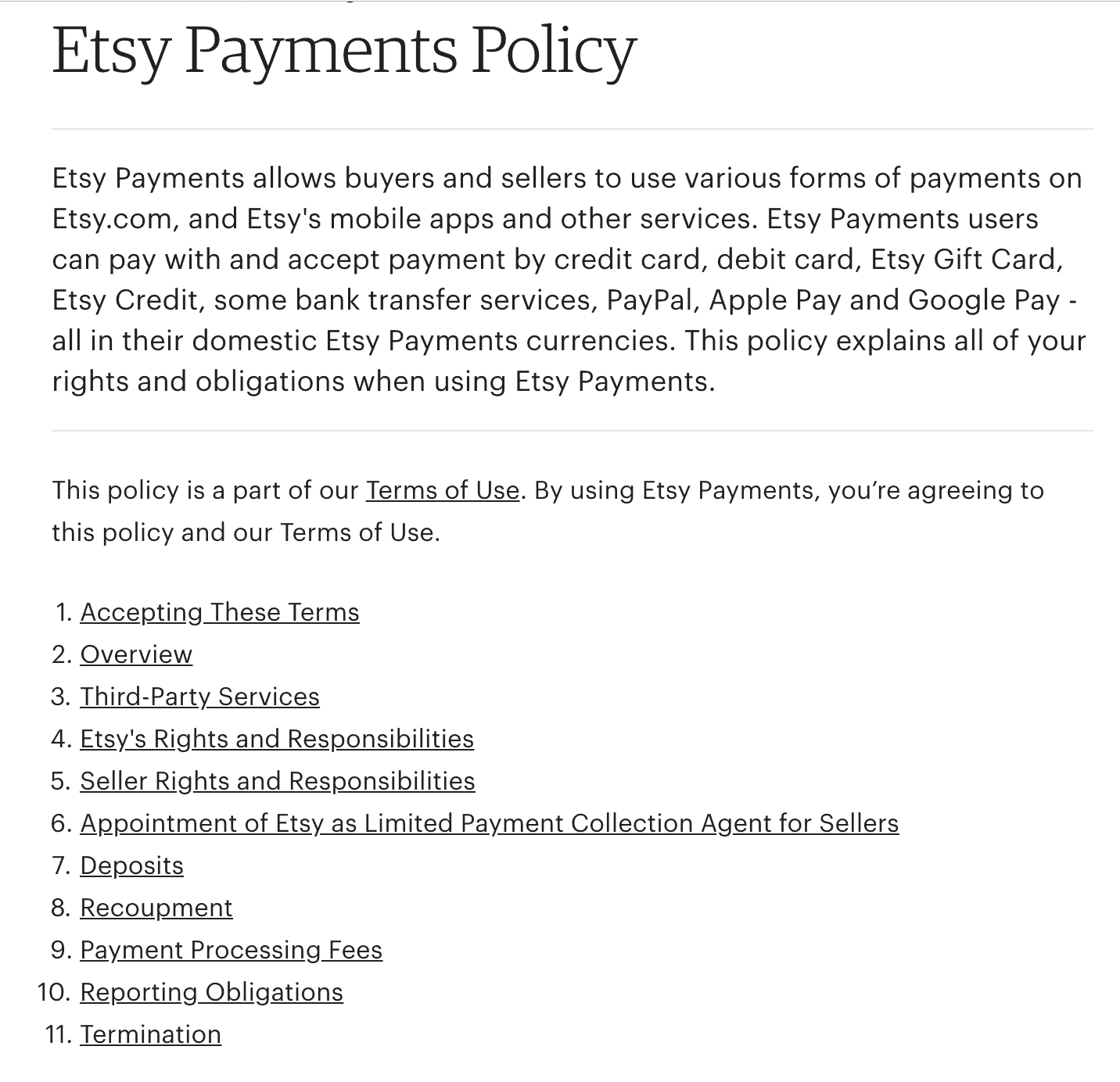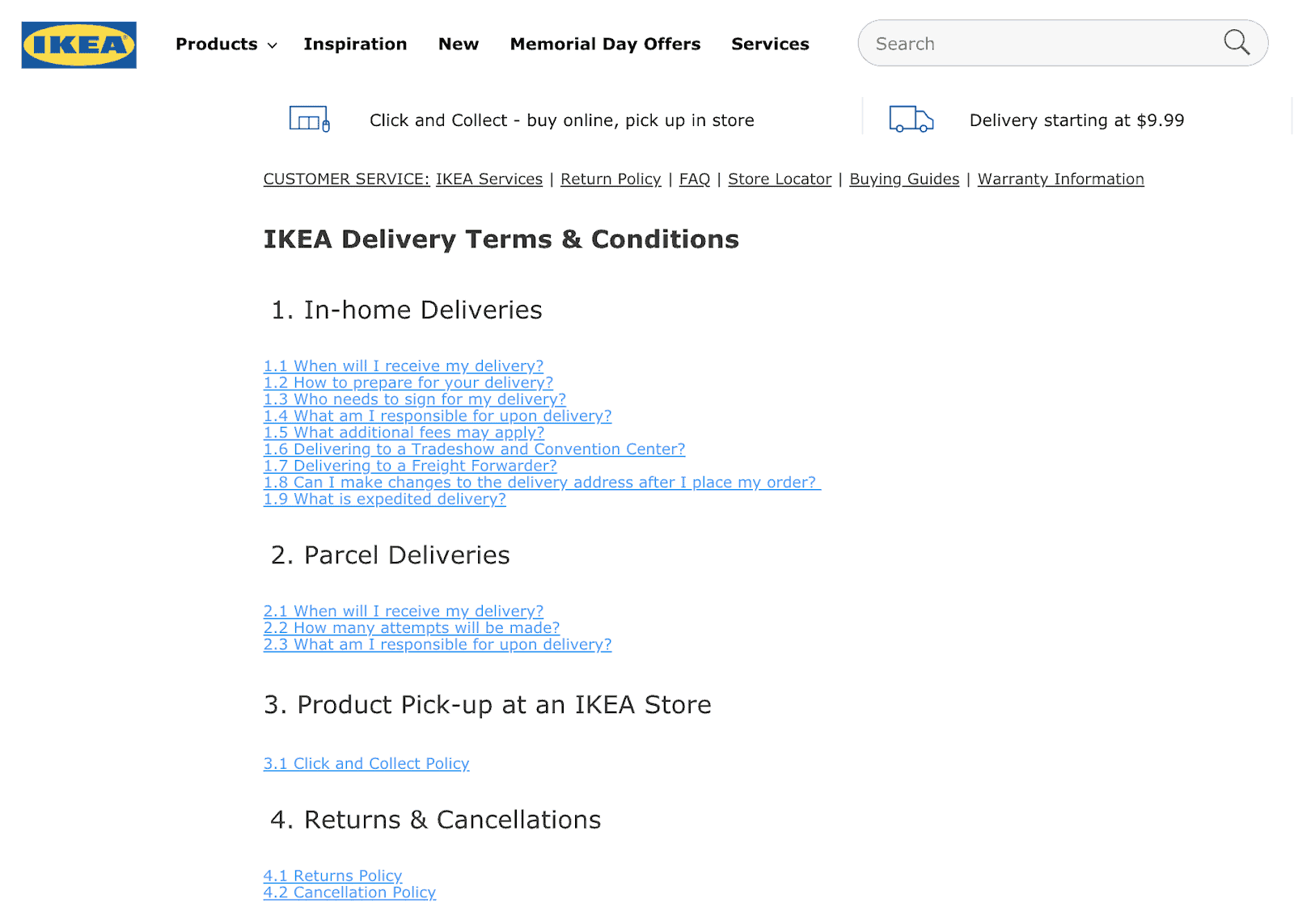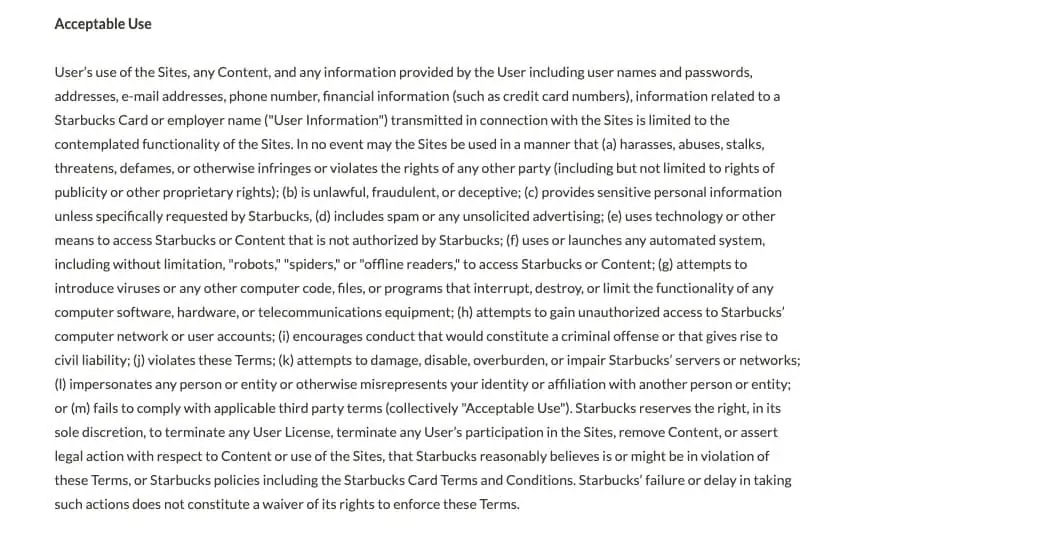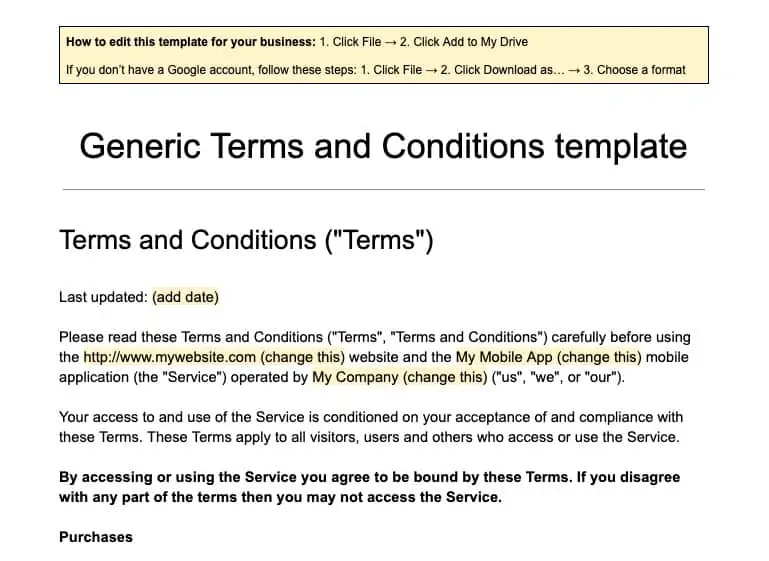What is an ecommerce Terms and Conditions (T&C) document?
Your Terms and Conditions (T&C) is a contract between you and your customer. Customers must agree to your terms in order to browse your site, make purchases, or use any associated services. By laying the code of conduct for your site and how visitors interact with it, your T&C gives you legal cover in the case of any disputes which might arise.

Why should you have Terms and Conditions for your ecommerce site?
While it’s true that hardly anyone reads a site’s T&C document, it’s still a good idea to create one for your website, particularly if you’re an ecommerce merchant. Here are the top reasons to outline your Terms and Conditions:
1. It provides legal protection
This might come as a surprise, but there is no legal requirement for ecommerce businesses to provide Terms and Conditions on their site. Because of this, many businesses make the mistake of thinking that T&C aren’t that important. But you risk leaving yourself open to legal action if you don’t have one.
Legal disputes cost a lot of time and money, and for the most part can be easily avoided if you put some pre-emptive groundwork in — i.e., your Terms and Conditions. When you set very clear rules of conduct, you can stave off a dispute before it happens. So, no matter what it is that you sell on your ecommerce site, you should make sure you are protected against any nasty surprises, such as misuse of your site or plagiarized content.
2. Your T&C can build customer trust
Being transparent with how you operate makes you much more trustworthy to consumers, compared with you having no Terms and Conditions available at all. This is important because trust is among the biggest concerns that consumers have when it comes to online purchases. Having well-crafted T&C could well be the difference between your customer choosing you over a competitor.
What to include in your Terms and Conditions
Now that we’ve discussed the importance of having Terms and Conditions for your ecommerce site, let’s discuss what it should include. Every website is different so, the sections of your T&C may vary, but here are some of the most common components typically included in an ecommerce site’s terms.
1. Information accuracy
If you are running an ecommerce site with a lot of product pages, it can be a full-time job making sure that all the information is accurate. It’s one of the most likely errors that will occur in your online store, so it opens the door to a lot of customer service issues. For this reason, it’s very important that you stipulate that information can sometimes be inaccurate and change without notice.
This section should mention that despite your best efforts, on-site information might not be up-to-date and that certain information (e.g., prices, product descriptions, stock quantities) may change without notice.
Below is an extract from clothing retailer H&M’s T&C section on information accuracy:

H&M clearly states that information on its site is not always up to date, and that information (including pricing) can change at any time. As a clothing retailer, it also makes specific reference to how the color of garments may look different online due to screen configurations. This is important, considering that 54% of consumers have returned items bought online due to complaints over color.
2. Terms of sale
This part of your T&C should set out clear terms on how products can be purchased, whether there are any restrictions e.g. the restriction of sale for age-restricted products and services, and what happens in the event that a product cannot be supplied.
HBO’s ecommerce T&C outlines this quite well. Its “Terms of Sale” section mentions that by placing orders on the site, the customers represent that they are of legal age and that the information they provide is true and accurate. The terms also mention that HBO takes steps to verify customer information prior to accepting and order and that the company has the right to accept, modify, or decline orders.

3. Payment terms
This is where you will cover any terms relating to the payment of the product/service you sell. This is one of the biggest areas of liability for your business, so you need to make sure that your customers understand the expectations surrounding online transactions.
The payment terms section of your site should include:
- The payment methods you accept (Visa, Mastercard etc.)
- Missed/late payment conditions
- How you will handle refunds/returns
- How you will handle payment disputes
Because they are an intermediary between the buyer and seller, Etsy has very comprehensive T&C for its site. It establishes the rights and responsibilities of both the buyer and the seller. It also states that in agreeing to their T&C, the customer is also agreeing to the T&C of third-party services such as PayPal as well.

4. Shipping & delivery
This is an area that has a lot of potential for error in ecommerce. A delivery could get delayed, damaged in transit — or not arrive at all. This is especially important if you use a 3PL provider or freight company. This is because your business no longer has direct control over what happens to orders. But the buck stops with you, as far as your customer is concerned. Although this is important for any seller, it has particular relevance to those who sell products that are more logistically difficult to fulfill.
That’s why it’s essential to outline your shipping and delivery terms, in which your discuss the amount of time it takes to fulfill orders, how costs are calculated and whether extra fees are applicable, and what your level of responsibility includes when third parties are involved.
If we go onto IKEA’s Terms and Conditions, we can see that they have laid a specific page just for delivery and shipping information:

If we look into the details of what IKEA’s T&C covers, it’s pretty exhaustive and written in an FAQ format for the sake of clarity. The T&C specify, among other things, how the estimated delivery date is calculated, between what hours deliveries are made, and what additional fees may be added.
Many ecommerce businesses may not need delivery and shipping T&C as comprehensive as IKEA. However, it’s very important that your T&C make provisions for order processing and shipping times.
5. Intellectual property
As an online business, you are more likely to be vulnerable to intellectual property theft in the form of your logo, business name or site theme. For this reason, you need to protect your intellectual property within your T&C by stating your ownership over such features.
An intellectual property clause should act to ensure that brands or trademarks are not misused in any way and clearly state that nothing contained within the website should be construed as granting any license or the right to use any trademark without the prior written consent of the owner of the website.

Victoria’s Secret keeps its intellectual property section brief and to the point. It states that site content and features can only be used for ‘personal and informational’ purposes by the customer. Otherwise, any kind of reproduction without their permission is strictly prohibited.
6. Disclaimer of liability
Things don’t always go according to plan. Product losses, damages, injuries can occur. As such, your T&C should specify the damages that one party e.g. ecommerce store owner, will be obligated to provide to the other e.g. customer, in the event of product failure and should reflect the level of risk involved.
It will also specify what the ecommerce store owner will not be responsible for in the event of any loss, liability, damage (whether direct, indirect or consequential), personal injury or expense of any nature whatsoever which may be suffered by the customer.
Check out the following example from Alex and Ani:

7. External Links
If your site contains links to third-party websites, be sure to mention that such links are outside of your control and usage should be at the user’s/customer’s own risk.
Below is a good example from Wayfair, which has a “Links to Other Websites” section in its Terms and Conditions. In it, Wayfair states that any links pointing outside of its website are provided for the user’s convenience and that Wayfair isn’t responsible for the quality, nature, and reliability of third party content. The terms go on to state that the inclusion of third party links does not imply endorsement by Wayfair.

8. Loyalty programs and promotions
Consider including provisions around your promotional deals or loyalty programs. Below is an example from cosmetics retailer Sephora:

In its T&C, Sephora has dedicated specific passages to two of its well-known sales promotions. These are not regular features in ecommerce, so they wouldn’t be covered in a general T&C agreement. To avoid any liability, Sephora has laid out specific conditions.
For example, if a specific free sample is out of stock, the T&C state that Sephora can replace this with another sample at their discretion. They also state that gift cards do not contribute towards the minimum purchase requirement for promotional codes.
9. Terms of Use
Your website Terms of Use simply sets out the terms for accessing a website and applies to every single visitor. The Terms of Use usually cover items such as privacy and prohibited uses of the website.
Starbucks covers this in the “Acceptable Use” section of its T&C. In it, they state that their site must not be used to harass, abuse, defames, or violate the rights of any other party. The clause also says that Starbucks has the right to cancel any user’s participation in its sites if it deems that the user violated its terms.

How to create ecommerce Terms and Conditions
As you can see, your ecommerce Terms and Conditions covers a lot of ground. Drafting this document can seem daunting — and it could be, if you do it yourself. Fortunately, you don’t have to. Consider the following options when creating your terms and conditions:
1. Get legal help
If you have the budget for it, consider hiring a lawyer who specializes in ecommerce to draft your terms and conditions. This is a great option because it ensures that your terms are tailored specifically for your site.
That said, hiring a lawyer isn’t cheap, and this option can set you back hundreds if not thousands of dollars.
On that note, if you’re set getting help from a lawyer but don’t have a huge budget, you can consider using sites such as LegalZoom, which offers a service specifically for terms and conditions. You’ll schedule an appointment with a LegalZoom attorney, who’ll then learn about your business and draft your T&C docs for you.

In terms of costs, pricing starts at $399 for basic websites. Ecommerce merchants will likely need to shell out additional funds.
2. Use a Terms and Conditions generator
The next best thing is to use a T&C generator, such as the one offered by TermsFeed. The free tool lets you whip up a T&C document in minutes. Simply head to the site, fill out your website information, and go through a set of questions.

TermsFeed will then draft a T&C agreement based on your answers, and you can download the custom document as both HTML and text files.
3. Use a template
Another option is to use a terms and conditions template. It’s not ideal, but it can be useful if you want to educate yourself on basic and general T&C clauses. You can also use a template to figure which components to include in your own agreement and tailor the text for your business.
TermsFeed has a great T&C template, which you can download as a PDF, Google, or MS Word doc.

Country-specific consumer laws
Although Terms and Conditions aren’t legally required, that doesn’t mean that there isn’t legislation covering them. This can vary depending on where your ecommerce business is operating from.
It wouldn’t be realistic for you to write T&C for every jurisdiction, so it’s vital that you include a ‘Governing Law’ clause. This states what jurisdiction you’re operating from e.g. California and the United States. Any dispute will be dealt with under that jurisdiction and its laws.
But as your business grows, it’s a good idea to review your T&C to make sure they comply with the legislation in key regions. The examples below are not mandatory everywhere but are still considered “best practice” for T&C, so it’s worth bearing them in mind as you write your own.
Provide detailed information on the refunds and returns process (UK & Australia)
This area is the most thoroughly covered in country-specific consumer protection laws. This is because they were originally designed to apply to purchases that take place in offline retail settings.
In both the UK and Australia, your T&C have to stipulate clear guidelines for returns and refunds. In ecommerce, returns and refunds are likely one of the biggest concerns that consumers will have. According to Shopify, 89% of consumers have returned an online purchase in the last three years. So, it’s very important that this is covered in accordance with your jurisdiction.
Under the UK’s Consumer Contracts Regulations 2013, consumers have the right to cancel their online order until 14 days after they receive their goods. They also have the right to a full refund within 14 days of their goods being returned to the seller.
Under Australian consumer law, any ecommerce business must specifically state in its T&C that it complies with Australian consumer law. You must also state exactly how your refunds and return policy operates. A blanket “no refunds” policy is not allowed, because you need some kind of provision is the case that a product is faulty. You can, however, state a time period within which a refund can be claimed.
Make language clear and accessible (EU)
Using too much legal jargon in your T&C can set you up for issues in the long run. Using so-called “legalese” (technical legal writing not used in common language) might look official. But it’s also dense and difficult for the average consumer to understand. From a legal standpoint, this puts you in a grey area.
Because it’s difficult to comprehend, it’s possible that your customers might misunderstand your T&C — or have no idea what they’re saying at all. It’s all too easy for a more unscrupulous entity to sneak in some fine print.
New legislation prevents businesses from using legalese as a cover for terms that consumers are unlikely to agree with. Last year, the EU passed the General Data Protection Regulation (GDPR) the most comprehensive data privacy law in history. Amongst other changes, the GDPR specifically states that:

So, ‘using clear and plain language’ in your T&C isn’t just a matter of good form – it also avoids your T&C from being considered void within the European Union.
Recognize that your T&C are null and void if they violate consumer laws (United States)
T&C are void under U.S. law if they violate any state or federal consumer laws. This is regardless of how and whether consumers have ‘consented’ to them, as stated here by the American Bar Association:

This list is by no means exhaustive, so it’s up to your business to investigate the details of the consumer protection laws in your jurisdiction.
Other best practices for creating your ecommerce Terms and Conditions
Here are additional tips and best practices to beef up your T&C agreement:
Choose a common-sense layout
As we’ve already discussed, a typical T&C agreement covers a lot of different areas. So, you want to make it easy as possible for an interested party to navigate. The chance is that there will be a specific sections they are interested in. Having a dedicated table of contents at the top which links to different sections is very helpful, as it avoids your customer having to scroll for miles to find what they want. Make sure that you use bold headings to head up the different sections for readability. For the same reason, a plain font is a must!
Below is a great example from the department store Nordstrom:

Make sure your T&C are regularly updated
It’s important that you revisit your T&C from time to time. You might need to make amendments in response to site changes, or new laws coming into effect in the jurisdiction you operate in. If your T&C become out of date, then you lose the legal protections you wrote them for in the first place.
It’s a good idea to show your customer that your T&C are revisited regularly, as this will give them more confidence in your operation. You can do this by placing the date of the last revision at the top of the page, as Shopify has done:

Think about the best way to obtain consumer consent
If you want maximum legal protection, it’s a good idea to require some form of affirmative action on behalf of your customer. For example, you can make your customers tick an ‘I agree to the terms and conditions’ box to proceed with checkout. This is known as the ‘clickwrap method’, and you can use this in any part of your site where T&C are in effect (such as account sign-ups or content submissions).
It’s important that you include hyperlinks in here to your T&C. This means that regardless of whether a customer has actually read your T&C or not, they have been given “reasonable notice and opportunity” to do so. This makes your T&C legally binding in most cases.
Final words
Drafting a T&C agreement might seem like a big drain of your time, but it’s a vital part of running an ecommerce business. Legal disputes are a nightmare for any merchant, especially when they could have been avoided.
Putting in the effort to develop your T&C sets you up well as your business grows, and helps you to avoid any liability where it can hurt you the most. If you want to ensure long-term success, it’s vital that you take preventing measures, starting with your Terms and Conditions.
You may also be interested in:


